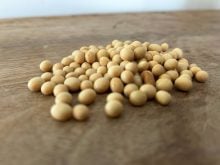SASKATCHEWAN
Warm weather in the second week of July assisted crop development and haying.
On July 15, livestock producers had 29 percent of the hay crop cut. Across the province, 66 percent of fall cereal, 65 percent of spring cereals, 66 percent of oilseed and 72 percent of pulse crops were at normal stages of development.
Most parts of the province have received rain recently, with flooding, hail and wind causing significant damage in some areas.
Across the province, topsoil moisture was rated as 82 percent adequate on July 15.
Read Also

U.S. corn and soybean yields revised down by USDA
Soybean and corn yields in the United States were revised downward from earlier estimates in updated supply/demand tables from the United States Department of Agriculture released Nov. 14.
South
Topsoil moisture in the region is mostly adequate, although many areas have received rain, including the Manor area, which has received 72 millimetres in the July 9-15 period. The Moosomin and Mankota areas have both received more than 300 mm of rain since April 1.
Storms, hail and wind have damaged some crops, and there are issues with localized flooding.
On July 15, crop development in the southeast generally lagged behind the southwest, where 88 percent of the fall cereals, 76 percent of spring cereals, 79 percent of oilseeds and 52 percent of pulse crops were at normal stages of development.
Grasshoppers, alfalfa weevil and cabbage seedpod weevil have damaged some crops, and producers are spraying for diseases, including sclerotinia, wheat midge and fusarium head blight.
Hay quality across southern Saskatchewan is mostly rated as good.
Central
Topsoil moisture ratings in mid July were positive — between 79 and 86 percent adequate across the region — as were pasture conditions, although there are issues with excess moisture in some areas.
In the east-central regions, 72 percent of fall cereals, 71 percent of spring cereals, 72 percent of oilseeds and 77 percent of pulse crops were in normal stages of development on July 15. In western parts of the region, fall cereals fared better at 89 percent normal.
Flooding has damaged crops, and the region has continued to see rain, although some crops required more moisture in the middle of the month.
There are issues with lodging and flattening of cereal crops following recent storms, as well as issues with cereal leaf diseases and wheat midge.
Forage crops are being hayed and baled.
North
Topsoil moisture ratings on cropland were 60 percent adequate in the northeast on July 15, but better in the northwest, where they were pegged at 84 percent adequate.
The region has continued to see rain, with the Vonda and Meadow Lake areas receiving close to or more than 300 mm since April 1.
In the northeast, 66 percent of spring cereals, 63 percent of oilseed and 74 percent of pulse crops were at normal stages of development in mid July. Conditions elsewhere in northern Saskatchewan were similar.
There has been damage from localized flooding, wind and hail. Disease issues are present and producers are spraying for cereal leaf disease, fusarium head blight, sclerotinia and wheat midge.
There are reports of grasshoppers in the northeast.
Hay quality ratings were 67 percent good in the northeast and 73 percent good in the northwest.
MANITOBA
Crops in southwestern Manitoba have received light to severe damage following strong winds, rains and hail in mid-July.
Growing conditions are more positive in other areas of the province where crops are advancing and haying and fungicide work is underway.
Southwest
Rainfall in the second week of July varied from 10 mm to as much as 125 mm in the Pipestone, Reston, Hartney and Pierson regions. The rain was accompanied by hail and wind.
Many crops were damaged, and there is severe lodging in some cereals and canola. Moisture and flooding issues in the far southwestern part of the region have been reported, as well as lots disease pressure.
Soybeans are outperforming most other crops in the region and were in the bud and early flower stage July 15.
Northwest
Field conditions and moisture levels are improving, although surplus moisture is an issue in some fields.
Crop development and conditions vary. On July 15, cereals were rated as 75 percent good to fair and canola 65 percent.
Some cereal and forage seed crops in the region have required control for grasshoppers. Trap counts for bertha armyworms are increasing.
Central
Warm temperatures have helped crops advance. Most parts of the region have received rain, although standing water isn’t a common concern.
There are reports of blackleg lesions in the southwestern part of the region, which required fungicide applications.
Ongoing monitoring of crops is recommended because bertha armyworm trap counts are increasing.
The first cut of beef-quality hay produced average yields.
Eastern
Crops in the eastern region are developing well. On July 15, winter wheat was at the milk to soft dough stage, canola was 100 percent flowering, kernel development was beginning on spring cereals and soybeans were in early pod development. Some corn fields have started to tassel.
Some growers have sprayed for grasshoppers.
Interlake
Growers continued to make fungicide applications through the middle of July.
Winter wheat crops are ripening, oat fields have started to head and soybeans and flax are flowering.
Grasshoppers in the region will require insecticide.
Many hay stands in the region required more rainfall and are producing below average yields. Those that received adequate rain are producing better at more than two tonnes per acre.














